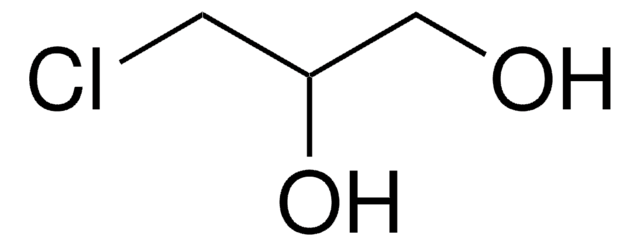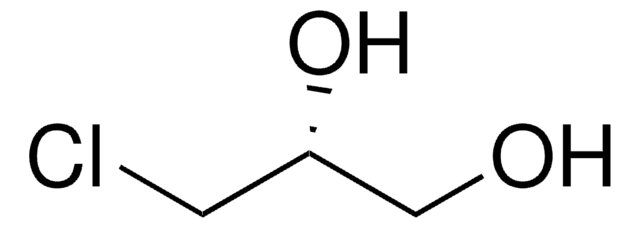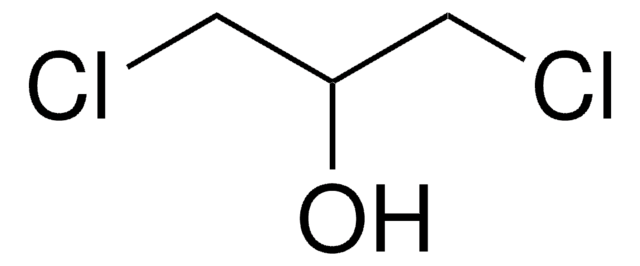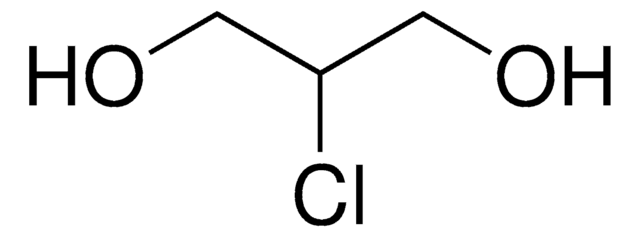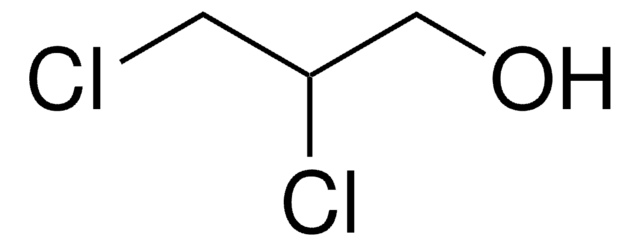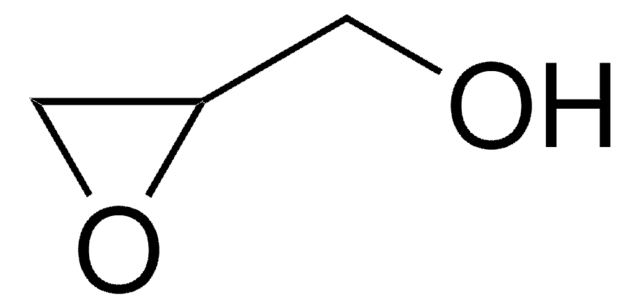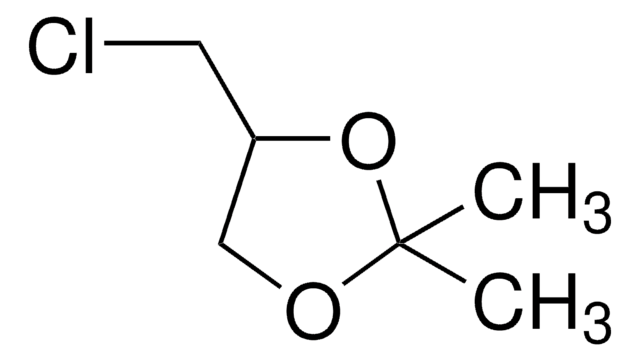107271
(±)-3-Chloro-1,2-propanediol
98%
동의어(들):
α-Chlorohydrin, α-Glycerol chlorohydrin, α-Monochlorohydrin, 3-MCPD
로그인조직 및 계약 가격 보기
모든 사진(2)
About This Item
Linear Formula:
ClCH2CH(OH)CH2OH
CAS Number:
Molecular Weight:
110.54
Beilstein:
635684
EC Number:
MDL number:
UNSPSC 코드:
12352100
PubChem Substance ID:
NACRES:
NA.22
추천 제품
vapor pressure
0.04 mmHg ( 25 °C)
Quality Level
분석
98%
refractive index
n20/D 1.480 (lit.)
bp
213 °C (lit.)
solubility
H2O: soluble
alcohol: soluble
diethyl ether: soluble
density
1.322 g/mL at 25 °C (lit.)
작용기
chloro
hydroxyl
SMILES string
OCC(O)CCl
InChI
1S/C3H7ClO2/c4-1-3(6)2-5/h3,5-6H,1-2H2
InChI key
SSZWWUDQMAHNAQ-UHFFFAOYSA-N
유사한 제품을 찾으십니까? 방문 제품 비교 안내
관련 카테고리
일반 설명
3-Chloro-1,2-propanediol undergoes enantioselective transformation to (R)-3-chloro-1,2-propanediol by the cell extract of Corynebacterium sp. strain N-1074 . It is a contaminant found in food in free (diol) form as well as in an esterified (with fatty acids) form.
애플리케이션
(±)-3-Chloro-1,2-propanediol may be used in manufacture of dye intermediates.
생화학적/생리학적 작용
3-Chloro-1,2-propanediol is a potent rodent chemosterilant.
신호어
Danger
Hazard Classifications
Acute Tox. 2 Inhalation - Acute Tox. 3 Oral - Carc. 2 - Eye Dam. 1 - Met. Corr. 1 - Repr. 1B - Skin Irrit. 2 - STOT RE 1 - STOT SE 1
표적 기관
Kidney, Testes
Storage Class Code
6.1A - Combustible acute toxic Cat. 1 and 2 / very toxic hazardous materials
WGK
WGK 3
Flash Point (°F)
235.4 °F - closed cup
Flash Point (°C)
113 °C - closed cup
개인 보호 장비
Eyeshields, Faceshields, Gloves, type ABEK (EN14387) respirator filter
이미 열람한 고객
T Nakamura et al.
Journal of bacteriology, 174(23), 7613-7619 (1992-12-01)
During the course of the transformation of 1,3-dichloro-2-propanol (DCP) into (R)-3-chloro-1,2-propanediol [(R)-MCP] with the cell extract of Corynebacterium sp. strain N-1074, epichlorohydrin (ECH) was transiently formed. The cell extract was fractionated into two DCP-dechlorinating activities (fractions Ia and Ib) and
Antifertility activity of 3-chloro-1, 2-propanediol (U-5897) on male rats.
E Samojlik et al.
Biology of reproduction, 2(2), 299-304 (1970-04-01)
W Seefelder et al.
Food additives & contaminants. Part A, Chemistry, analysis, control, exposure & risk assessment, 25(4), 391-400 (2008-03-19)
3-Mono-chloropropane-1,2-diol (3-MCPD) is a contaminant that occurs in food in its free (diol) form as well as in an esterified (with fatty acids) form. Using a simple intestinal model, it was demonstrated that 3-MCPD monoesters and 3-MCPD diesters are accepted
Ching-Yu Lin et al.
Reproductive toxicology (Elmsford, N.Y.), 28(1), 75-80 (2009-06-06)
Sperm ATP is derived primarily from either glycolysis or mitochondrial oxidative phosphorylation. In the present studies, (1)H NMR spectroscopy was used to characterize the metabolite profile in primate sperm treated either with alpha-chlorohydrin (ACH), a known inhibitor of sperm glycolysis
Z Zelinková et al.
Food additives & contaminants. Part A, Chemistry, analysis, control, exposure & risk assessment, 25(6), 669-676 (2008-05-20)
A series of twelve breast milk samples were analysed by gas chromatography-mass spectrometry (GC/MS) operated in selected ion monitoring mode for 3-chloropropane-1,2-diol (3-MCPD). Whilst none of the samples contained 3-MCPD above the limit of detection of 3 microg kg(-1) milk
자사의 과학자팀은 생명 과학, 재료 과학, 화학 합성, 크로마토그래피, 분석 및 기타 많은 영역을 포함한 모든 과학 분야에 경험이 있습니다..
고객지원팀으로 연락바랍니다.